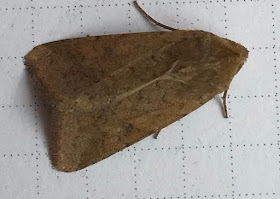Two further species for the 2019 garden list over the past few days have been November Moth (10th, genitalia checked) and Large Wainscot (8th), while new for the autumn season but already recorded here at the beginning of the year after hibernation have been Grey Shoulder-knot (9th) and Dark Chestnut (6th).
 |
| November Moth, Westcott 10th October |
 |
| Grey Shoulder-knot, Westcott 9th October |
 |
| Large Wainscot, Westcott 8th October |
Fairly typical of the garden actinic's results since Monday, last night the trap brought in 136 moths of 27 species:
Blastobasis lacticolella (1),
Emmelina monodactyla (1), Mallow (2), Red-green Carpet (1), November Moth (2), Cypress Pug (1), Silver Y (1), Green-brindled Crescent (4), Rosy Rustic (1), Barred Sallow (4), Pink-barred Sallow (1), Sallow (5), Dusky-lemon Sallow (1), Beaded Chestnut (2), Red-line Quaker (2), Brick (6), Lunar Underwing (30), Dark Chestnut (2), Merveille du Jour (1), Brindled Green (1), Deep-brown Dart (2), Black Rustic (35), Turnip (1), Large Yellow Underwing (18), Lesser Yellow Underwing (6), Square-spot Rustic (1) & Setaceous Hebrew Character (4). Other species seen over the previous four nights included
Agonopterix arenella,
Pseudargyrotoza conwagana,
Hypsopygia costalis, Pine Carpet, Common Marbled Carpet, Willow Beauty, Light Emerald, Vine's Rustic, Frosted Orange, Angle Shades, Large Wainscot, Yellow-line Quaker, Chestnut, Grey Shoulder-knot, Satellite, Common Wainscot & Shuttle-shaped Dart. Numbers of Lunar Underwing (currently 2,200+ for the year) are now declining but Black Rustic (750+) is still going strong. Brick has had a little burst of activity, reaching 17 in one night on the 8th, but the only other moth getting into double figures now is Large Yellow Underwing.
The picture below really only serves to show how difficult it can be to separate Dark Chestnut from Chestnut in a photograph. Like a lot of other moths, it is far easier when you have the specimen(s) in your hand. The Dark Chestnut (lower) is playing dead and its wings are held more tightly together than usual so the straight line made by the ends of both wings is not as obvious here as it could be. While this example is certainly darker than the Chestnut they do both vary quite a lot in ground colour. The 'greasy' appearance of Dark Chestnut doesn't often come out well in a photograph either.
 |
| Chestnut & Dark Chestnut, Westcott 9th October |
Dave Wilton
Westcott, Bucks


















































